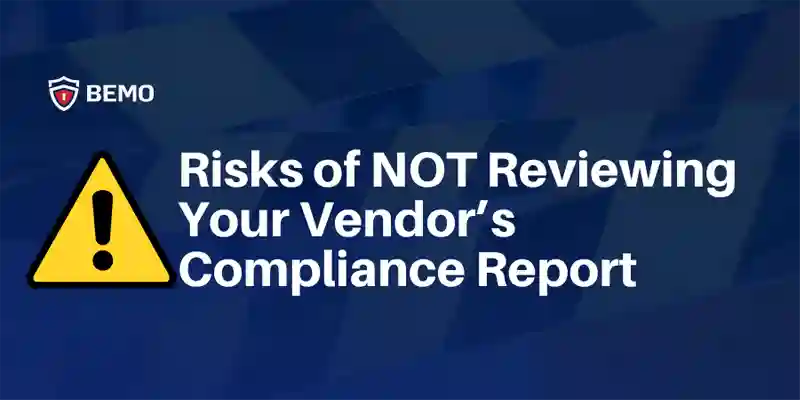2 min read
Risks of Not Reviewing Your Vendor's Compliance Report
![]() Laura Arce Fonseca
on Nov 07, 2024
Laura Arce Fonseca
on Nov 07, 2024

As a growing small business, you’re doing all the right things. You take small business security seriously. You have achieved the compliance frameworks necessary to take your small business to the next level. You have all your risks under control -- but what about risks post by your vendors?
Often, small businesses and startups overlook the critical step of reviewing their vendors’ compliance reports, assuming obtaining an attestation is enough. And far too often these 3rd party vendors can pose a significant threat that must be understood.
Without a comprehensive examination of compliance reports from your vendors, you may remain unaware of the security measures implemented by third parties handling your data. Neglecting this step could leave you exposed if a vendor slips up, putting your reputation and your own compliance at risk.
It’s shockingly common: cybercriminals are well aware of the gaps posed by popular vendors and target these vendors as gateways to get their hands on their ultimate goal – your small business (read in detail what the Infosecurity Magazine has to say about this topic)!
In this article you will learn about the importance of reviewing your vendor’s compliance report to protect your organization.
- How Managed Compliance Can Help Review Vendor Compliance Reports
Why Vendor Compliance Matters for Startups
Startups often rely on third-party vendors for diverse services, including IT support, cloud storage, and data management. While these partnerships help drive business efficiency, they also introduce potential vulnerabilities.
For example, a vendor’s SOC 2 attestation is essential, but it’s not enough to simply accept the certificate at face value. You need to ensure that the attestation aligns with your industry-specific frameworks, whether it’s SOC 2, ISO 27001, NIST 800, HIPAA, or CMMC. Moreover, the attestation must be up-to-date. Audits are typically conducted annually, and a lot can change in a year.
Vendor compliance should be a living process, not a one-time check.
Consequences of Non-Compliance for Startups
The potential fallout of a vendor’s non-compliance can be severe, especially for startups with limited resources to handle crises. First and foremost, your reputation is at risk. A data breach, even one originating from a third-party vendor, can cause customers to lose trust in your brand. The damage may be hard to reverse, and startups often cannot afford to lose credibility in their early stages.
Additionally, non-compliance can lead to legal and financial consequences, fines, and penalties for both the vendor and your business.
Regulatory frameworks like SOC 2, ISO 27001, HIPAA, and others exist to protect data and ensure that companies follow best practices for security. Failing to verify your vendors’ compliance with these frameworks means putting your startup in legal jeopardy.
On top of that, the aftermath of a third-party breach can disrupt your day-to-day operations, leading to operational downtime, loss of critical data, and the need for extensive investigations. All this can cost you time and resources that could have been better spent growing your business.
Startups need to be nimble and efficient, and a third-party compliance failure can throw that off course.
How Managed Compliance Can Help Review Vendor Compliance Reports
For startups looking to stay ahead of these risks, Managed Compliance for small businesses or startups is the fastest way to get compliant and mitigate the potential pitfalls associated with vendor compliance. Using Compliance as a Service (CaaS) solutions and compliance automation offers startups the benefit of compliance automation. Rather than manually checking and maintaining compliance, Compliance Automation for small businesses and startups can ensure that both your business and your vendors are continuously adhering to necessary frameworks.
With so many moving parts in a startup environment, leveraging CaaS ensures that your compliance processes are streamlined and efficient.
If you want to understand how to review your vendor’s SOC 2 Report, we provide all the juicy details in our article below. Follow our step-by-step guide and interpretation of each “chapter” of a SOC 2 report so you do not get lost in the process and can make better-informed business relationships.
Top 10 Posts
-
Google Workspace to Office 365 Migration: A Step-by-Step Guide
-
Office 365 MFA Setup: Step-by-Step Instructions
-
How to Migrate from GoDaddy to Office 365
-
Migrate From Gmail to Office 365: 2024 Guide
-
What are the 4 types of Microsoft Active Directory?
-
How to remove Office 365 from GoDaddy (tips and tricks)
-
How to Set Up Office Message Encryption (OME)
-
CMMC Meaning : A Comprehensive Guide for Startups
-
What is Microsoft Purview ? Your A to Z Guide to Getting Secure Fast
-
What is The CIA Triad?



Leave us a comment!